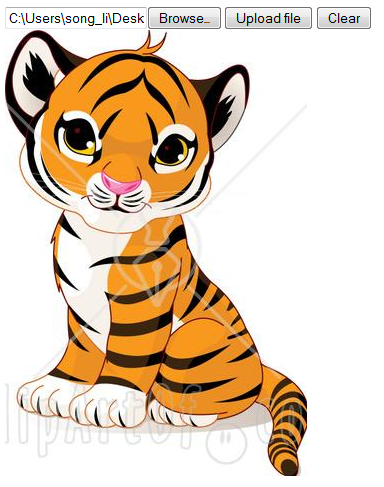Introduction
This study note presents a simple example to upload files to the server by jQuery Ajax calls.
Background
Simple things are good. In Engineering, being simple normally means reliability and performance. This study note presents a simple example to upload files to the server by jQuery Ajax calls. The server side code is in Java, but if you do not use Java, you can skip the server code and directly go to the Javascript code. It is a simply example anyway.

- The attached is a Maven project;
- The server side code is implemented as a Spring MVC controller;
- The client side code is implemented in the simple "index.jsp" file;
- The project uses Java 8 and Tomcat 7. If you want to try this example by yourself, I would recommend JDK 8 and Eclipse Luna Java EE IDE for web developers or above.
I will assume that you have some general background on Maven, Spring MVC, and jQuery. If you are not familiar with these, you can always check out the internet to get the ideas on them.
The server side code
The attached is a Maven project, the POM file is the following:
<project xmlns="http://maven.apache.org/POM/4.0.0"
xmlns:xsi="http://www.w3.org/2001/XMLSchema-instance"
xsi:schemaLocation="http://maven.apache.org/POM/4.0.0 http://maven.apache.org/xsd/maven-4.0.0.xsd">
<modelVersion>4.0.0</modelVersion>
<groupId>com.song.example</groupId>
<artifactId>jquery-simple-upload</artifactId>
<version>0.0.1-SNAPSHOT</version>
<packaging>war</packaging>
<properties>
<spring.version>4.1.7.RELEASE</spring.version>
<jackson.version>2.6.1</jackson.version>
<tomcat.version>7.0.55</tomcat.version>
</properties>
<dependencies>
<dependency>
<groupId>org.springframework</groupId>
<artifactId>spring-core</artifactId>
<version>${spring.version}</version>
</dependency>
<dependency>
<groupId>org.springframework</groupId>
<artifactId>spring-web</artifactId>
<version>${spring.version}</version>
</dependency>
<dependency>
<groupId>org.springframework</groupId>
<artifactId>spring-webmvc</artifactId>
<version>${spring.version}</version>
</dependency>
<dependency>
<groupId>commons-fileupload</groupId>
<artifactId>commons-fileupload</artifactId>
<version>1.3.1</version>
</dependency>
<dependency>
<groupId>com.fasterxml.jackson.core</groupId>
<artifactId>jackson-core</artifactId>
<version>${jackson.version}</version>
</dependency>
<dependency>
<groupId>com.fasterxml.jackson.core</groupId>
<artifactId>jackson-databind</artifactId>
<version>${jackson.version}</version>
</dependency>
<dependency>
<groupId>org.apache.tomcat</groupId>
<artifactId>tomcat-servlet-api</artifactId>
<version>${tomcat.version}</version>
<scope>provided</scope>
</dependency>
</dependencies>
<build>
<plugins>
<plugin>
<artifactId>maven-war-plugin</artifactId>
<version>2.4</version>
<configuration>
<warSourceDirectory>webcontent</warSourceDirectory>
<failOnMissingWebXml>true</failOnMissingWebXml>
</configuration>
</plugin>
<plugin>
<artifactId>maven-compiler-plugin</artifactId>
<version>3.3</version>
<configuration>
<source>1.8</source>
<target>1.8</target>
</configuration>
</plugin>
</plugins>
</build>
</project>
The "web.xml" and the "mvc-dispatcher-servlet.xml" file are the following:
="1.0"="UTF-8"
<web-app xmlns:xsi="http://www.w3.org/2001/XMLSchema-instance"
xmlns="http://java.sun.com/xml/ns/javaee"
xsi:schemaLocation="http://java.sun.com/xml/ns/javaee
http://java.sun.com/xml/ns/javaee/web-app_3_0.xsd"
id="WebApp_ID" version="3.0">
<display-name>D3 Example</display-name>
<welcome-file-list>
<welcome-file>index.jsp</welcome-file>
</welcome-file-list>
<filter>
<filter-name>nocachefilter</filter-name>
<filter-class>com.song.example.filter.NocacheFilter</filter-class>
</filter>
<filter-mapping>
<filter-name>nocachefilter</filter-name>
<url-pattern>/*</url-pattern>
</filter-mapping>
<servlet>
<servlet-name>mvc-dispatcher</servlet-name>
<servlet-class>
org.springframework.web.servlet.DispatcherServlet
</servlet-class>
<load-on-startup>1</load-on-startup>
</servlet>
<servlet-mapping>
<servlet-name>mvc-dispatcher</servlet-name>
<url-pattern>/api/*</url-pattern>
</servlet-mapping>
<context-param>
<param-name>BaseUrl</param-name>
<param-value>
http://localhost:8080/jquery-simple-upload/
</param-value>
</context-param>
</web-app>
="1.0"="UTF-8"
<beans xmlns="http://www.springframework.org/schema/beans"
xmlns:xsi="http://www.w3.org/2001/XMLSchema-instance"
xmlns:p="http://www.springframework.org/schema/p"
xmlns:context="http://www.springframework.org/schema/context"
xmlns:mvc="http://www.springframework.org/schema/mvc"
xsi:schemaLocation="
http://www.springframework.org/schema/beans
http://www.springframework.org/schema/beans/spring-beans-3.2.xsd
http://www.springframework.org/schema/context
http://www.springframework.org/schema/context/spring-context-3.2.xsd
http://www.springframework.org/schema/mvc
http://www.springframework.org/schema/mvc/spring-mvc-3.2.xsd">
<context:component-scan base-package="com.song.example.controller" />
<mvc:annotation-driven />
<bean id="multipartResolver"
class="org.springframework.web.multipart.commons.CommonsMultipartResolver">
<property name="maxUploadSize" value="1048576"/>
</bean>
</beans>
The MVC controller that takes the uploaded file is implemented in the "FileController" file:
package com.song.example.controller;
import java.io.InputStream;
import java.util.HashMap;
import javax.servlet.http.HttpServletResponse;
import org.apache.commons.io.IOUtils;
import org.springframework.stereotype.Controller;
import org.springframework.util.Base64Utils;
import org.springframework.web.bind.annotation.RequestMapping;
import org.springframework.web.bind.annotation.RequestMethod;
import org.springframework.web.bind.annotation.ResponseBody;
import org.springframework.web.multipart.MultipartFile;
import org.springframework.web.multipart.MultipartHttpServletRequest;
@Controller
public class FileController {
@RequestMapping(value = "/echofile", method = RequestMethod.POST, produces = {"application/json"})
public @ResponseBody HashMap<String, Object> echoFile(MultipartHttpServletRequest request,
HttpServletResponse response) throws Exception {
MultipartFile multipartFile = request.getFile("file");
Long size = multipartFile.getSize();
String contentType = multipartFile.getContentType();
InputStream stream = multipartFile.getInputStream();
byte[] bytes = IOUtils.toByteArray(stream);
HashMap<String, Object> map = new HashMap<String, Object>();
map.put("fileoriginalsize", size);
map.put("contenttype", contentType);
map.put("base64", new String(Base64Utils.encode(bytes)));
return map;
}
}
- The "echoFile()" method takes the uploaded file though the "MultipartHttpServletRequest" object;
- It converts the file content into Base64 format and returns the Base64 content in the JSON response;
The goal of this example is to use jQuery Ajax to upload a file to the server and receive the responded JSON object. Now let us take a look at the client side code.
The client side code
The client side code is implemented in the "index.jsp" file. The HTML part of the file is the following:
<body style="font-family: calibri; font-size: 8pt">
<div>
<form id="fileForm">
<input type="file" name="file" />
<button id="btnUpload" type="button">Upload file</button>
<button id="btnClear" type="button">Clear</button>
</form>
<div id="imgContainer"></div>
</div>
</body>
The Javascript part of the file is the following:
<script type="text/javascript">
var isJpg = function(name) {
return name.match(/jpg$/i)
};
var isPng = function(name) {
return name.match(/png$/i)
};
$(document).ready(function() {
var file = $('[name="file"]');
var imgContainer = $('#imgContainer');
$('#btnUpload').on('click', function() {
var filename = $.trim(file.val());
if (!(isJpg(filename) || isPng(filename))) {
alert('Please browse a JPG/PNG file to upload ...');
return;
}
$.ajax({
url: '<%=baseUrl%>api/echofile',
type: "POST",
data: new FormData(document.getElementById("fileForm")),
enctype: 'multipart/form-data',
processData: false,
contentType: false
}).done(function(data) {
imgContainer.html('');
var img = '<img src="data:' + data.contenttype + ';base64,'
+ data.base64 + '"/>';
imgContainer.append(img);
}).fail(function(jqXHR, textStatus) {
alert('File upload failed ...');
});
});
$('#btnClear').on('click', function() {
imgContainer.html('');
file.val('');
});
});
</script>
The jQuery reference is to the jQuery CDN "<script src="//code.jquery.com/jquery-2.1.4.min.js"></script>". If you want to run this example on your own computer, you need to make sure that you have the internet access, so your browser can download jQuery from the CDN.
- The HTML part declared a file input in an HTML form;
- In the click event of the "btnUpload" button, an Ajax call is issued to upload the file. The data to be uploaded is a "FormData" object;
- Upon a success Ajax call, a JSON response is received. The JSON object should have the Base64 content responded from the server.
- In order to show the responded data, I insisted that only JPG/PNG images can be uploaded. The responded Base64 image will be displayed on the web page.
Run the example
To run the example, you can issue a Maven command to compile the project and deploy the "war" file to a Tomcat server. You can also import the project into Eclipse and run from the Eclipse. If you are not familiar with importing Maven projects into Eclipse, you can check out this link.

You can browse an image file and upload it. The "FileController" converts the file to Base64 content and responds it back to the browser. You should notice that the browser is not refreshed and it is a true Ajax call.
Points of Interest
- This study note presents a simple example to upload files to the server by jQuery Ajax calls;
- You may think that this example is too simple and I definitely agree with it. I like simple things and I think I will be using the method in future projects.
- I hope you like my postings and I hope this example can help you one way or the other.
History
- First revision - 8/21/2015
